Penney Peirce's Blog, page 4
September 23, 2019
Penney Has a New Breath-of-Fresh-Air Website

Penney’s Redesigned Website Is Finally LIVE!!!
WhooHoo! HeeHaw! and WhoopdeeDo!
I worked on redesigning and updating my old, very outdated website for most of 2019. It’s been a labour of love, and thanks so much to my dear friend and webmaster, Alan Kantor, in northern California. I shifted from Dreamweaver to WordPress and Divi, and entered a huge new learning curve. Here’s the link to the archives.
September 18, 2019
10 Books that Influenced Me Spiritually

These books were highly instrumental in helping me wake up and develop greater wisdom and compassion. The common elements in these—and all the books I’ve integrated into myself over the years—are a quality of deep honesty, resonance with higher truth, and a succinct, personal, direct writing style. They are listed in random order.
Seth Speaks, The Seth Material, etc. by Jane Roberts
A number of the Jane Roberts/Seth books opened and expanded my mind as I was first realizing that my passion lay in the spiritual realms and not just the physical. I loved the concepts Seth described: the oversoul, the nature of the self and higher self, the All That Is, how evolution functions. . . This view touched me deeply. I wasn’t drawn to religion but Seth’s philosophy and description of patterns of consciousness felt just right—a higher, more inclusive understanding of universal truths—and the energy of it really woke me up and motivated me!
Initiation, by Elizabeth Haich
I had been fascinated by Taylor Caldwell’s and Joan Grant’s novels about past lives—the “Far Memory” books—but Initiation hit me square in the gut. Haich describes her insights into the subtle workings of karma, reincarnation, and spiritual development as she recalls in great detail her memory of past life initiation into the mystical teachings of ancient Egypt. As I read it, I was there; I “knew” everything she was describing. And it stirred in me a great desire to recall my own previous experiences and be able to integrate them into my present life.
The Emerald Tablets of Thoth the Atlantean, translated by Dr. M. Doreal
In my early awakening years, I was given a variety of esoteric and metaphysical books filled with ancient teachings. I received the original translations of the Emerald Tablets as splotchy photocopies before the popular versions of the book ever came out. The rhythm of the writing and its power drew me in and patterned or re-patterned me as I read the words. Though I wasn’t sure what it all meant at the time, once again, I “knew” it. I would only have to read a section to become recentered and have the feeling of being much more vast than I’d ever considered possible. This has remained true throughout the years whenever I pick up the book again. It’s as though it’s encoded and transmits much inner knowledge through its sound and rhythm.
The Starseed Transmissions, Return of the Bird Tribes , and The Third Millenium, by Ken Carey
This is a rare series of prophetic books that describes in straight-forward, clear language what is happening and going to happen on the earth. Again, the resonance of the truth in Carey’s direct translation of his spiritual transmissions affected me and aligned me. Here was a simple man, living away from the crazy masses, in touch with nature, who was an extremely clear channel. That inspired me to develop myself to the same degree. His writings still hold up and are pristine and gorgeous.
The Carlos Castaneda series: The Teachings of Don Juan, A Separate Reality, Journey to Ixtlan, etc.
Oh, my gosh! Where to start on these! I’ve probably read them all three times. Perhaps I was integrating my shaman lives while I absorbed these, but the books contain so many subtle teachings about energy and consciousness, male and female ways of learning, and the various levels of awareness. Wow! The writing style has directness, humor, lack of pretension, and an enigmatic, surprising quality that conveyed the information straight to my body.
The Mind of the Cells, by Satprem and Sri Aurobindo: The Adventure of Consciousness, by Satprem
Satprem was a kind of secretary to The Mother, Sri Aurobindo’s “spiritual partner.” He followed her around taking notes as she described her process of diving into her body to experience how the cells respond to fear, and to love. Her poetic and precise descriptions of her direct experience are powerful. As she cleared fear from her body, she reached a point where her cells panicked because they didn’t have a set of instructions to live by—their old habit of contraction and caution—and she often fainted or blanked out. As she began to reinforce love and compassion as the new mode of living, the cells adapted and life became frictionless. The life force flowed without restriction, the soul became fully embodied. Her path to discover a new way to be human required immense patience and discipline, and she was able to paint a “tactile picture” of the divine feminine path into enlightenment—the path down and in, not up and out.
Satprem’s masterwork on Sri Aurobindo is a powerful, equal, free-standing, companion piece to the Mother’s great work. In it, Aurobindo says, “They must enter into the last finite if they want to reach the last infinite.” This book is rich with inspiration and guidance about experiencing the divinity in matter and “the plunge of light into its own shadow” to find the overmind—his word for cosmic consciousness without the loss of the individual. All Satprem’s books are precious—what a service he performed for humanity!
I Am That, by Sri Nisargadatta
I am not particularly drawn to gurus, but Nisargadatta was an amazing person. This book is a compilation of dialogues he had with students and seekers, and what impresses me is the simplicity of his words (almost to the point of seeming ordinary) that simultaneously reach to the heart of any issue, beyond the messiness of the mind. There are no extraneous words, and his language actually carries the vibration of what he’s describing. When I felt that, I realized I wanted to be able to write like that. This book is full to the brim with single sentences of inspiring and actionable advice—any one of which will transform you if you practice it.
Awakened Imagination, The Power of Awareness, The Neville Reader, etc. by Neville Goddard
I’m so glad I discovered this man. He was an articulate teacher of the philosophy called New Thought, working primarily between the late 1930s and his death in 1972. His many books teach us the nuances of working with perception—mental, emotional, and physical—in the present moment. He says, “However much you seem to be living in a material world, you are actually living in a world of imagination.” Learning to perceive in alignment with universal principles is so key to our path out of the limited mind, back to our enlightened selves, and Neville (his preferred nom de plume) made an art-form of “mental science.” He also helped interpret passages from the Bible in a way that moved beyond the literal interpretation to reveal the inner, deeper, spiritual, universal, experiential, energy-and-consciousness function.
Evolution’s End, The Biology of Transcendence, Crack in the Cosmic Egg, etc. by Joseph Chilton Pearce
Joe Pearce wrote an amazing array of books about child and human development and spiritual transcendence, merging his knowledge of physics, biology, psychology, and spiritual growth to help us develop our non-ordinary consciousness. He emphasized the integration of Mind and Heart to speed our evolution, upgrade our biology, and increase our mystical experience. And, he explained how nature governs over an intelligent unfolding of our life, which to me is deeply reassuring. I love his books because they merge the worlds and help us find personal and societal unity. He was an original thinker who was intellectual and brilliant and had also had many paranormal experiences. His body of work is reality-altering.
The Great Initiates, by Edouard Schuré
This is not a popular book but it remains on my bookshelf as an important reference. How were the lives of the spiritual masters—those who shaped world thought—modeled? How did they come into their wisdom? What difficulties did they overcome and what challenges of their particular day and age did they both use and rise beyond? How did they work with energy, with language? In this time when so many think they’ve discovered spiritual truth, it’s good to remind ourselves of those who walked the path before us and did the hard work. They made it easier for us to rediscover essential wisdom and integrate it.
——————————————-
I also want to mention a few other authors who have affected me (in no particular order): David Spangler, Barbara Hand Clow, Zecharia Sitchin, Lyall Watson, Terry Tempest Williams, Edmond Bordeaux Szekely, Michael Brown, Michael Talbot, Helen Schucman (The Course in Miracles), Erich Fromm, Chogyam Trungpa, Rainer Maria Rilke, Alan Watts, and and and. . . I am grateful to all the clear-minded, beautiful writers who have shared themselves so authentically.
I admit that since I began writing my own books, I’ve not read much from contemporaries—partly because I want to maintain the freshness and originality of what comes through me. I know we all represent the same wisdom through different lenses and that is vitally important for thorough understanding. The bits I’ve read from people like Eckhart Tolle, Esther Hicks/Abraham, Jon Kabat Zinn, and Byron Katie, to name a few, are deeply soul-satisfying.
September 16, 2019
On “Creativity” and Being Constantly Contemporary
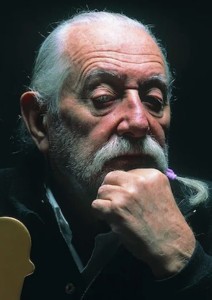
Ettore Sottsass, Italian Architect, Designer, and Founder of the Memphis Group, (1917-2007), from a video from 2000:
I find it very difficult to talk about contemporaneity. The fate of contemporaneity does not stop anyone, but I cannot—with the tiny cells of my brain—adhere completely. I have a vision of it that is not as happy, optimistic, or as hopeful as the industry and tech propaganda want to assert it as being. I have a basic intention, which is to preach calmness. One of the things that scares me the most is this culture of competition. We talk about success, selling, not selling… (as though) life is an act of competition. I wonder where this begins and where it ends.
Can we preach a culture where relationships are always carefully studied and, if anything, dulled, rather than accelerated and sharpened? In contemporary industry, there is a large distribution of competitive culture—through advertising. For example, the impact of multinational corporations is the result of competitive aggression against underdeveloped countries. We’re making agreements to rip them off. These aspects of contemporary culture don’t calm people, but make them nervous. There is a great state of general neurosis—and a designer, at this point, what can he do? Increase these general neuroses, or try to create objects that calm people.
I hate the word ‘creativity’, because it is a word invented on Madison Avenue by advertisers. It’s clear that the industry needs to renew itself continuously, because otherwise it does not sell. People get bored, generations change and you have to change everything. This is about industry, it’s not about society. Industry needs advertising, and advertising needs creativity because the market needs to renew itself continuously. It’s a game; it’s a destiny. Since there has been industry, it has gradually been subjected to its own destiny—which is what it is.
I don’t think that Leonardo considered himself a creative person, and I don’t even think he considered himself an artist. He considered himself a technician who was capable of doing these things—capable of making a horse so powerful to please his Lord, or the warrior placed on it, and to express this situation. I believe that all antiquity was made more by craftsmen than by artists. Much less talk about creativity or foolishness or surprises.
It may be that contemporary society, precisely because of these mechanisms of accelerated communication, is accelerating on all sides towards a consumption of existence that is conditioned by the necessity of industry, and may continually need spectacle, and therefore creativity. Everything must be spectacular. Fashion is always new. Cars are always new, even medicines are always new. The way of walking is always new. The ways of going on vacation. The ways to know the world—everything is accelerated and always new.
It may well be that a humanity will be born for which life, existence, is permanently a spectacle. I do not know this, and I don’t criticize it either. I know that creativity—that is, invention—is strictly conditioned from market needs. And the needs of the market are strictly conditioned by the production itself. It’s a closed circle. So, I would like to end here. I’ve thrown a stone in the pond, let’s see what happens.
August 28, 2019
Confucius on Leadership
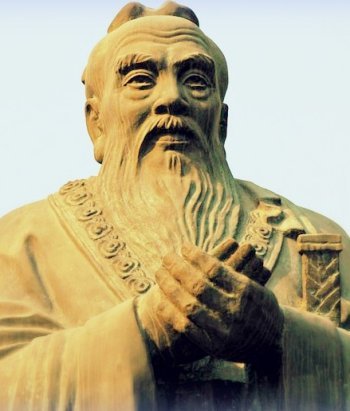
How far we have strayed from this great wisdom!!
Confucius (551 BC–479 BC) had as central to his philosophy the concept of Deliberate Tradition that would organize society around education, the content of that education, and the social life that would engender.
Confucius used five key terms to describe how this would be implemented: Jen, the virtue of benevolence and love; Chun tzu, the ideal person, who as the opposite of the petty, mean, or small-spirited person, was real and authentic, someone at home in the universe; Li, a kind of savoir faire, the knowledge of how to comport oneself with grace and urbanity whatever the circumstance—in those key relationships between husband and wife, elder siblings and junior siblings, ruler and subject. The fourth key term is Te, which means power, specifically the power by which people are ruled.
Confucius wanted to address the fallacy of oppressive rule. He rejected the Realists’ claim that the only effective rule is by physical might. He showed how past Realist dynasties (Ch’in, for example) had been stunningly successful at the start, but collapsed in less than a generation. Confucius noted that the three essentials of government were economic sufficiency, military sufficiency, and the confidence of its people. He stressed that the popular trust was by far the most important, for “if the people have no confidence in their government, it cannot stand.”
This spontaneous consent from its citizens, this morale without which nations cannot survive, arises only when people sense their leaders to be people of capacity, sincerely devoted to the common good and possessed of the kind of character that compels respect. In the final analysis, goodness becomes embodied in society neither through might nor through law, but through the impress of persons we admire.
If the leader whose sanction springs from inherent righteousness, such a person will gather a cabinet of “unpurchaseable allies.” Their complete devotion to the public welfare will quicken in turn the public conscience of local leaders and seep down from there to inspire citizens at large. For the process to work, however, rulers must have no personal ambitions, which accounts for the Confucian saying, “Only those are worthy to govern who would rather be excused.”
The final key to Confucius’ society was Wen. This refers to “the arts of peace” in contrast to “the arts of war.” It refers directly to music, art, poetry, and the sum of culture in its aesthetic and spiritual mode. He also added a political dimension to this notion of wen, and how it succeeds in international relations. Here again the Realists answered in terms of physical might; it was the answer Stalin echoed in the last century when, asked how the Pope figured in a move he was contemplating against Poland, asked in return, “How many battalions does he have?”
Ultimately, Confucius maintained that victory goes to the state that develops the highest, the most exalted culture—the state that has the finest art, the noblest philosophy, the grandest poetry, and gives evidence of realizing that “it is the moral character of a neighborhood that constitutes its excellence.” In the end, it is these things that elicit the spontaneous admiration of women and men everywhere, and thus establish a deliberate tradition of civilization.
June 28, 2019
Superconscious Guidance

Remember: Superconscious guidance is always marked by love and is always empowering.
As we seek to apply intuition for practical purposes, I can think of few other applications as important as obtaining accurate guidance for ourselves and sharing our well-intentioned insights about others with them. As you begin practicing this intuitive skill, it will behoove you to make a quick check: How open are you to hearing the truth, either from within or without? Can you comfortably share your personal truth with others?
Superconscious guidance is easy to obtain. It’s available in every moment, no matter where you are or what you’re doing. You must only ask, look and listen. If you can’t for some reason recognize a superconscious message inside your own brain, rest assured that the higher powers will use a friend, a rival, a stranger, a license plate on a passing car, a billboard, a song lyric or an actor in a movie to speak your own higher mind to you. Similarly, you may unwittingly be used to speak important messages to others. Guidance is pouring out of all of us, in everything we say and do. So we must be willing to share and be ever on the alert to notice and respect the ideas of others.
Copyright by Penney Peirce, from The Intuitive Way, third edition
May 24, 2019
I Was a Man Once

I was a man once
in another life
I remember it fuzzily and distantly
I am sure I loved some things, some people
with all my heart in that taken-over way
and I confess I expressed it
reservedly and
often intellectually or mythically or
I referred to other things
like nature or God or the brotherhood of warriors,
when I meant
the love of a lover or child who was so personal to me
that I didn’t dare touch it directly
for fear of disintegration
I was a woman once, or twice, or thrice
who gave everything in her heart
to a man who left without a word,
or with hard-hitting words,
or saw her as deficient or as a hole
to be emptied into that could magically
absorb pain and shame, or
as a consciousness superior to his
to whom he could not be devoted
but only jealous of instead, or
as a free spirit he wanted to possess
but could only have if he let her go
and trusted her.
I have lived the pain of women
raped, beaten, abandoned, stalked, and killed
because they loved their own life
and couldn’t continue to sacrifice it
to appease men’s pain
women who were used and discarded,
who died in childbirth
who died alone, whether young or old
And I have lived the pain of men
beaten down by fathers, shaped unnaturally by mothers
men who couldn’t please women and lost them
men who yearned so deeply for the spiritual connection
women provide
men who achieved material success but lost their heart
men who had heart but lived as involuntary monks
men who felt pride in “having” many women
but who never knew them
men who died of suicide by heart attack, alcoholism, drugs,
righteousness, bitterness, reckless violence, loneliness,
success, or gun
Let us feel down and through these earthly stories
to the joys, blessings, and gifts of being: man and woman
to remember the sacred gifts of both
we have both in us
at every moment
we are bigger than both
we are the sacred marriage
and that is something greater than two
it is an experience
of the best
of both
loving the best of each other
May 17, 2019
Capitalist? Marxist? Socialist? Why Choose the Old Fear View?
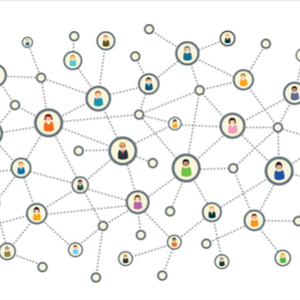
I wrote this in 2008, in regard to the treatment of Obama, but the same thing arises again in 2019, as conservatives haul out those loaded words—Capitalist and Socialist—to try to polarize voters. Those are OLD words that describe fear-based realities like the 5 years of McCarthyism in the early 1950s, or the 3 hot years of Nixon’s Watergate scandal in the early 1970s.
We, as intuitives and visionaries, are supposed to be on the leading edge of the new unity-based, love-based reality—the “new paradigm.” Through our ability to experience oneness via intuition, and by our ability to know the unified field via our energy-sensitivity, we are the ones who can show others the way into realities that are based on fellowship, mutual support, conscious communion, and the healing of ancient emotional wounds and human suffering.
You cannot open up spiritually and enter the new energy-based reality that is presenting itself to us, without understanding—at a visceral level—the profound interconnectedness of all life, and that includes people of all political persuasions. If we really want to live this new life, we must look for new organizational models that reflect the “new” truths. Both capitalism (and I like what Thom Hartmann says, that we are now in the “cancerous stage of capitalism”) and communism/socialism, and all other forms of national organization, are by themselves flawed. They are functional in particular ways, and dysfunctional in other ways.
The West functions according to one system, and the East by another. People from both East and West think their way is “the way life is”—unless you travel and work globally. When you do, you see the sanity of other ways of thinking and acting as perfect designs for specific situations and conditions, it humbles you and expands your perspective. For me, being international has expanded my view of what might happen if varying worldviews could be merged, if we could learn “how to be” in each other’s actual reality constructs.
So, politically, why are we reacting, or snapping back to a time when the world was highly divided and separatist? We are living into a time of global commonality, of shared humanity, where solutions are going to HAVE TO involve everyone and class distinctions are going to have to eventually disappear in the light of our Soul Awareness.
Is this Marxist? Socialist? I think not. I think we are headed toward an evolution of the best in capitalism and the best in socialism. We have to reexamine core motives and concepts, and reinvent politics, governance, nationality, and commerce.
So I’m asking those in reactionary mode: What are you so afraid of, and why are you choosing to live in a fear-based reality, unconsciously leaping back into the past, instead of being fully engaged in this super-alive moment, creating a new reality directly from soul, something that is fresh and new? Security is an issue that needs to be redefined as well—what does it look like when we come from an integrated view of reality?
I feel strongly that this present period offers us an amazing opportunity to reprogram our thinking, to be able to see through the old separatist logic, which is now downright stupid, into an ingenious new way of materializing improved solutions to problems, which are really not just national anymore, but part of a global healing process.
May 14, 2019
Falling Into the Heartfield
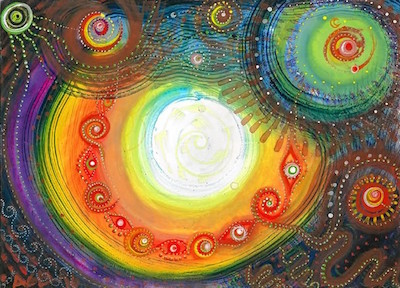
the first feeling as I cast myself into the world’s body
is: panic and pandemonium
then: the children are scared and whimpering
then: quiet mumbling by powerful men making plans
then: the women are comparing notes
then: the dogs are barking because they are alone
then: the winds are blowing madly and leaves are falling in the spring
then: birds are chirping because they are glad for the sun
and as I go farther, I feel the earth about to give birth
the cramping is beginning, the discomfort grows
and: she is happy!
and: the angels are here, very close!
and even so: horses are ripping grass to the left, then the right
under that noise is:
green and under the green is:
water at peace and:
air molecules swarming
and inside that movement is: raw excitement
then: I feel the pleasure of being alive
then: the exquisite pleasure of just being
and through it all:
a private amusement
we are in chaos
and we are unable to escape the gravity-pull of gratitude
it’s what makes us smile
the origin experience: of tiny smiles turning to full foolhardy grins
and: falling farther in I feel the wide-waking sleep
the coming birth has the power to expel particles like us
with a force we cannot fathom
far from the nest: into new home places
the feel of new homes we cannot anticipate
and: now I am stunned
with this experience of welcome
and can go no further tonight
copyright by Penney Peirce
May 12, 2019
Hurting Others with Energy: Part 5

As the frequency of energy in the earth—and correspondingly in our bodies and personalities—increases, we are becoming ultrasensitive and consciously empathic. We are becoming aware that we can hurt each other in many ways that are much more subtle than the rape, pillage, and murder of yesteryear, and the mental, emotional, and sexual abuse of yesterday.
For example, greed causes pain to others; when we believe we have to hoard, we cannot give love, so intent are we on “getting,” and this hurts others. When we selfishly take opportunities away from others, we never get to experience how they might help us of their own free will, and we deprive them of the opportunity to feel their own generosity.
When we believe we never have enough, that our self worth is based on riches, we often miss the experience of our spiritual roots, of our soul’s inherent abundance and ease of creating any reality it desires—and this adds to the false idea that the physical world is a place of suffering, and prolongs our collective misery.
Envy causes pain to others; when we think someone else is better than we are, or when we try to mimic them, we stall the expression of our own unique talents and destiny, which others may need. And simultaneously, when we project too much admiration or resentment onto a talented, self-expressive person, they may telepathically feel there is something wrong with expressing their talent because they’ve caused others to feel bad. How many people have kept themselves small because they might eclipse the reality of a parent or partner? When their joy diminishes, and their genius contracts, we all suffer the loss—including them.
When we allow ourselves to vent in repeating waves of anger, for example, we hurt others; we are choosing to indulge in frustration, which is self-contraction and the projection of criticism and the attempt to make others contract.
Our frustrations come from our own beliefs that something outside us has more power than we do. But it is we who set up the definitions and circumstances to deprive ourselves of the right to free self-expression in the first place, we who granted the power to others to tell us who we can or cannot be.
We are the ultimate authorities of our own existence! We are the only ones who can entitle ourselves to the full self-expression of our soul through our personality. No outside condition or person really has anything to do with it. But we allow ourselves to wound others: Why?
As we enter the Intuition Age, where we have a growing direct experience of the “rules” of how the unified field (or the unified Self) and Spirit operate, we will come to see that the current mental and emotional behaviors we accept as normal are actually prehistoric.
We will feel ashamed. We will want to make amends rather than continue to avoid facing the music, because to avoid “atonement,” or the recreation of the state of at-one-ment, will be too personally painful.
I looked up words and phrases that try to describe this incredibly important part of the transformation process; maybe one will inspire you:
remorse: deep regret or guilt for a wrong committed; contriteness; pangs of conscience; self-condemnation; self-reproach; ruefulness
day of reckoning; day of judgment; feel the implication of actions; come to grips with; face the consequences; contrition; repentance; penitence; compunction
reconciliation; reconcile: cause to coexist in harmony; make or show to be compatible; acknowledgment
I know people who refuse to apologize for bad behavior in spite of the fact that they know they’ve wounded the people they love most. They refuse to admit they might want to change or might need help in doing so, because their ego feels it must maintain control and a superior position to avoid feeling deeply unworthy.
Unfortunately, because of this ignorance, they remain isolated and encapsulated in a shell of invulnerability, unable to truly open to the gracious, lucky, and love-filled reality their heart would like to gift them with. And I must admit, I sometimes am angry with them, for depriving me of their true magnificence. But, really, what is so hard about turning a corner?
I believe there soon will come a time when each of us will voluntarily commit to becoming harmless. That means “I will not allow myself to act from a closed heart; I will not demean, abuse, or injure another person, animal, or plant.” No more excuses. No more postponement. The time is now to choose a spiritually-based, compassionate way of being in the world.
We stop the cycle of pain by not participating in it. It’s time to really get it that when we hurt another, we hurt ourselves, in so many ways. We will soon feel the hurt—instantly—when we hurt another. This doesn’t mean we don’t stand up for ourselves or say what we need. It doesn’t mean we don’t protect our loved ones from danger, or speak truth to power. Doing no harm does not equate with being wimpy.
When we remain isolated and encapsulated in a world of our own creation, not trusting the Flow, not enjoying what others spontaneously bring out in us, not indulging in the joy of surprise, we freeze a spot in the unified field, we hurt the Flow, and we hurt others who need the Flow to both supply them with inspiration and support, and take their expressions and contributions to others who can use these effluvia.
So I invite you to examine the subtle ways you withhold love, or withhold yourself, or refuse to receive, or judge what comes to you, or demean the life of others or of yourself. These are all ways we hurt others with energy.
Copyright by Penney Peirce
May 11, 2019
Leadership Lessons from Dancing Guy
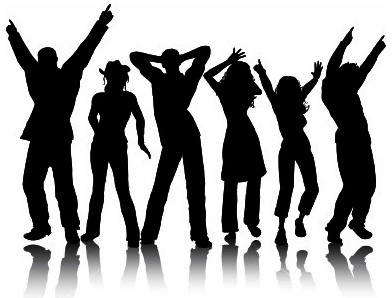
“In the beginning of a change, the patriot is a scarce man, brave, hated, and scorned. When his cause succeeds, however, the timid join him, for then it costs nothing to be a patriot.” —Mark Twain
Perhaps you’ve seen this before, but it’s certainly worth watching again! This is a powerful and funny and amazing video by Derek Sivers:
http://www.youtube.com/watch?v=fW8amMCVAJQ&feature=related
Here’s the transcript which is available at http://sivers.org/ff
If you’ve learned a lot about leadership and making a movement, then let’s watch a movement happen, start to finish, in under 3 minutes, and dissect some lessons:
A leader needs the guts to stand alone and look ridiculous. But what he’s doing is so simple, it’s almost instructional. This is key. You must be easy to follow!
Now comes the first follower with a crucial role: he publicly shows everyone how to follow. Notice the leader embraces him as an equal, so it’s not about the leader anymore — it’s about them, plural. Notice he’s calling to his friends to join in.
It takes guts to be a first follower! You stand out and brave ridicule, yourself. Being a first follower is an under-appreciated form of leadership. The first follower transforms a lone nut into a leader. If the leader is the flint, the first follower is the spark that makes the fire.
The second follower is a turning point: it’s proof the first has done well. Now it’s not a lone nut, and it’s not two nuts. Three is a crowd and a crowd is news.
A movement must be public. Make sure outsiders see more than just the leader. Everyone needs to see the followers, because new followers emulate followers — not the leader.
Now here come two more, then three more. Now we’ve got momentum. This is the tipping point! Now we’ve got a movement!
As more people jump in, it’s no longer risky. If they were on the fence before, there’s no reason not to join now. They won’t be ridiculed, they won’t stand out, and they will be part of the in-crowd, if they hurry. Over the next minute you’ll see the rest who prefer to be part of the crowd, because eventually they’d be ridiculed for not joining.
And ladies and gentlemen that is how a movement is made! Let’s recap what we learned:
If you are a version of the shirtless dancing guy, all alone, remember the importance of nurturing your first few followers as equals, making everything clearly about the movement, not you.
Be public. Be easy to follow!
But the biggest lesson here — did you catch it?
Leadership is over-glorified.
Yes it started with the shirtless guy, and he’ll get all the credit, but you saw what really happened:
It was the first follower that transformed a lone nut into a leader.
There is no movement without the first follower.
We’re told we all need to be leaders, but that would be really ineffective.
The best way to make a movement, if you really care, is to courageously follow and show others how to follow.
When you find a lone nut doing something great, have the guts to be the first person to stand up and join in.



